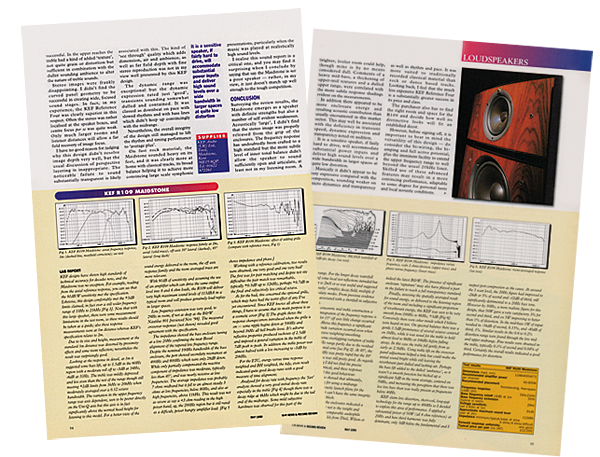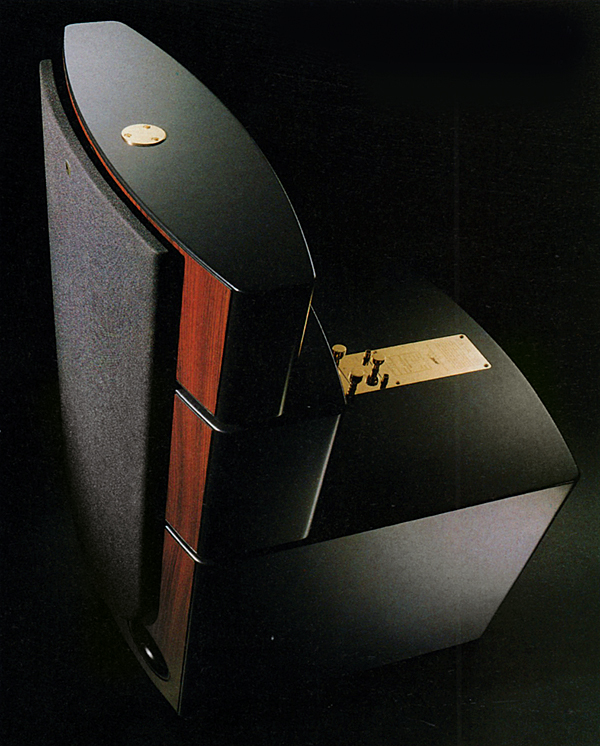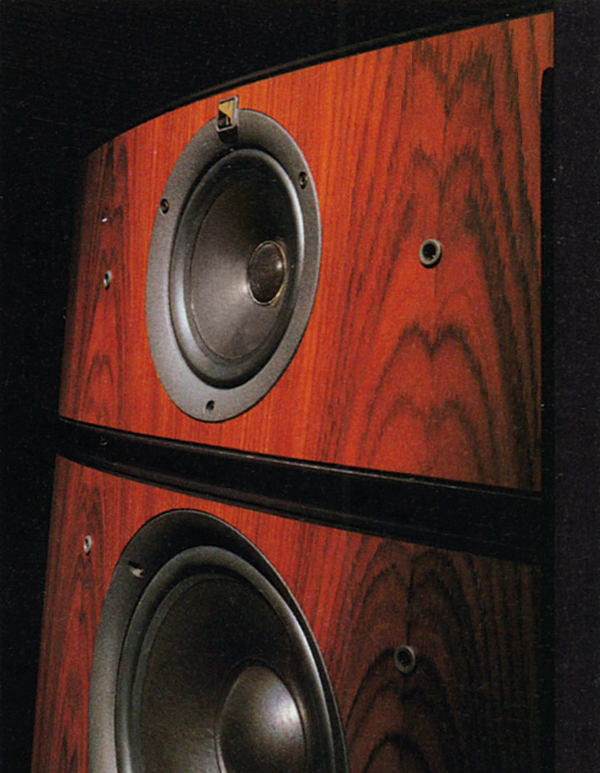Made in Maidstone Page 2
![]() Sound Quality
Sound Quality
Working initially with a modest amplifier and no special system alignment, first impressions were a little disconcerting. The Maidstone sounded rather low-key and distant, noticeably rich in tonal balance. I persevered and experimented with equipment combinations and placements, ultimately finding that I couldn't short-change this speaker and get away with it. Thus a Krell FPB650/Conrad-Johnson ART/Krell KPS25s lineup predominated – some £60,000+ worth of drive electronics! Meanwhile, a Linn LP12 Lingo/Naim Aro/Koetsu Rosewood Signature II deck provided analogue material via XTC and Conrad-Johnson Premier 15 phono equalisers.
Nice Touch
These big speakers could certainly deliver a big sound, powerful in the bass, broad in tonal balance, neither bright nor forward. At anything up to generous sound levels, the KEF R109 Maidstone sounded both smooth and big-hearted. Higher levels were generated without complaint from the drivers, though the sound itself could become increasingly aggressive, with the midrange dominating the proceedings. This meant that while high sound levels were possible in my room, they were certainly less comfortable than expected from the large scale and execution of this design.

Taking key areas in order of frequency, the bass was full, quite extended but softer in the lowest range and more forced, almost 'bumpy' in the mid-bass. As an entity in itself, despite the sure knowledge that much of the character of the bass sound is defined by the midrange, even low treble, the R109's bass was not very fast.
The result was that it tripped over fast drumming lines, lacked percussive impact and failed to deliver the kind of thrilling slam shown by some of the competition. In addition, the bass tune-playing ability – in other words the note-by-note evenness – I was only able to rate as 'average plus'.
The wisdom of using this particular bass driver combination was clear, for example in the case of the lower mid and its convincing integration with the bass. But this upper bass range also had a degree of coloration, showing hints of a 'boxy' or 'papery' effect which seemed to detract from the clarity, punch and focus of vocal lines. These had a thickened, almost plummy, emphasis.
The sound was cleaner in the upper midrange although some hard-to-qualify emphasis was also present making orchestral strings sound more 'wiry' and 'steely' than they should. A smooth, 'Uni Q' transition was present through to the treble and in no sense were you aware that a separate tweeter was working, a nice touch that.
Broad Balance
The in-room sound was noticeably dull through to the upper treble, even more than my past experience indicated with previous designs using this technology. Experiments with added treble lift were not really successful. In the upper reaches the treble had a kind of added 'texture', not quite grain or distortion but sufficient in combination with the duller sounding ambience to alter the nature of treble sounds.
Stereo images were frankly disappointing. I didn't find the curved panel geometry to be successful in creating wide, focused soundstages. In fact, in my experience, the KEF Reference Four was clearly superior in this respect. Often the stereo was rather localised at the speaker boxes, and centre focus per se was quite weak. Only much larger rooms and listener distances will allow a far field recovery of image focus.

I have no good reason for judging why this design didn't resolve image depth very well, but the usual discussion of perspective layering is inappropriate. The noticeable failure to sound substantially transparent is likely associated with this. The kind of 'see through' quality which adds dimension, air and ambience, as well as far field depth with fine stereo reproduction was not in my view well presented by this KEF design.
The dynamic range on offer was exceptional but the dynamic expression rated just 'good', transients sounding somewhat dulled and contained. It was classed as downbeat on pace with slowed rhythms and with bass lines which didn't keep up convincingly with the midrange. Nevertheless, the overall integrity of the design still managed to lift the rhythm and timing performance to 'average plus'.
On fast rock material, the R109 Maidstone sounded heavy on its feet, and it was clearly more at home with classical tracks, its broad balance helping it to achieve more convincing large scale symphonic presentations. This was particularly true when the music was played at realistically high sound levels. I realise this sound report is a critical one, and you may find it surprising when I conclude by saying that say this is not a poor speaker. Rather, in my view, it just doesn't match up well enough to the tough competition.
Conclusion
Surveying the review results, the R109 Maidstone emerges as a speaker with definite strengths but also a number of self-evident weaknesses. Acoustically 'large', I didn't find that the stereo image was properly released from the grip of the enclosures. The frequency response has undoubtedly been crafted to a high standard but the more subtle level of inner tonal balance didn't allow the speaker to sound sufficiently open and articulate, at least not in my listening room. A brighter, livelier room could help, though mine is by no means considered dull. Comments of a heavy mid-bass, a thickening of upper-mid textures and a dulled upper range, were correlated with the more subtle response shadings evident in my measurements.

In addition there appeared to be more enclosure energy and resulting acoustic contribution than usually encountered in this market sector. This may well be associated with the deficiency in transient speed, dynamic expression and transparency noted on audition.
It is a sensitive speaker, if fairly hard to drive, will accommodate substantial power inputs and deliver high sound levels over a wide bandwidth in larger spaces at quite low distortion. Musically it didn't appear to be very expressive compared with the competition, sounding weaker on micro dynamics and transparency as well as rhythm and pace. It was more suited to traditionally recorded classical material than rock or dance-based tracks. Looking back, I feel that the much less expensive KEF Reference Four is a substantially greater success in its price and class.
The purchaser also has to find the right room and space for the R109 and decide how well its distinctive looks will fit an established decor. However, before signing off, it is important to bear in mind the versatility of this design. Do consider the bi-wiring, the bi-amping and full active potential, not forgetting the imminent facility to extend the speaker's upper frequency range to well beyond the usual 20kHz limit. Skilled use of these advanced features may well result in a more convincing performance, adaptable to some degree for personal taste and local acoustic conditions.


















































